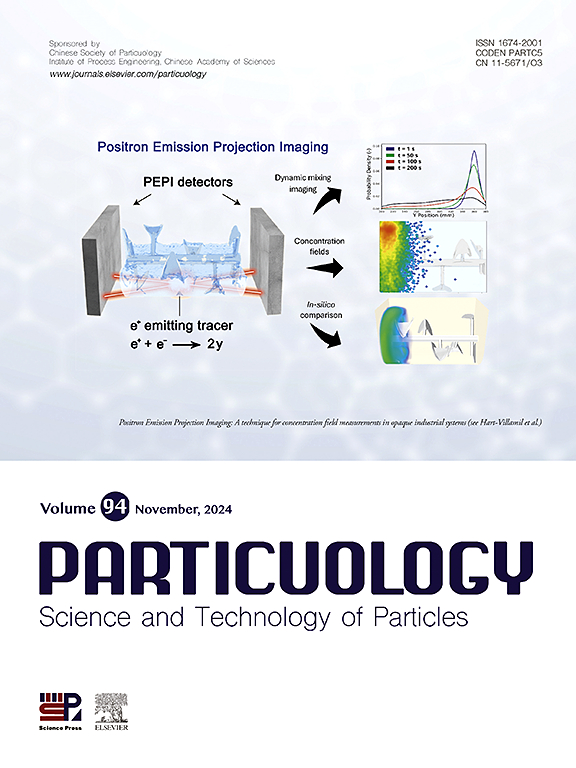Influence of flight structures and baffle dam on particle behaviors and gas-solid heat exchange enhancement in a rotary drum
IF 4.1
2区 材料科学
Q2 ENGINEERING, CHEMICAL
引用次数: 0
Abstract
In a waste heat recovery rotary drum with flights, particle lifting enhances gas-solid contact and introduces greater complexity to the particle motion. This study proposed strategies such as the segmentation and separation of flights (SSF) and the addition of baffle dams to establish a reasonable distribution of the particle curtain. A long drum model was developed, and DEM was employed to examine the effects of segment length, separation angle of flight, and position, height of baffle dam on particle motion and heat exchange capacity. The heat exchange efficiency of the system under the four special operating conditions was compared. The results showed that SSF enhanced the randomness of particle axial motion, while the development of the long drum model effectively identified the key factors influencing motion. The SSF formed a spiral-shaped particle curtain, exhibiting a high degree of particle distribution uniformity. The installation of the baffle dam enhanced the flight holding capacity and suppressed both transitional particle movement and backflow. With equivalent filling degree, compared to the uninterrupted flight, the SSF with bilateral baffle dam reduced the particle distribution non-uniformity by 61.72 %, while increasing the gas-solid contact area by 3.92 % and the bulk cooling temperature by 1.51 times.

飞行结构和挡板对转鼓内颗粒行为和气固换热增强的影响
在带飞行的废热回收转鼓中,颗粒提升增强了气固接触,并使颗粒运动更加复杂。本研究提出了分段和分离飞行(SSF)和增加挡板坝等策略来建立粒子幕的合理分布。建立了长鼓体模型,利用DEM分析了段长、分离飞行角、挡板位置、高度对颗粒运动和换热能力的影响。比较了系统在四种特殊工况下的换热效率。结果表明,SSF增强了颗粒轴向运动的随机性,而长鼓模型的建立有效地识别了影响运动的关键因素。SSF形成螺旋状颗粒幕,颗粒分布均匀度高。挡板坝的设置提高了飞行截留能力,抑制了过渡颗粒运动和回流。在充填程度相同的情况下,与不间断飞行相比,带双挡板的固体流化床颗粒分布不均匀性降低了61.72%,气固接触面积提高了3.92%,体冷却温度提高了1.51倍。
本文章由计算机程序翻译,如有差异,请以英文原文为准。
求助全文
约1分钟内获得全文
求助全文
来源期刊

Particuology
工程技术-材料科学:综合
CiteScore
6.70
自引率
2.90%
发文量
1730
审稿时长
32 days
期刊介绍:
The word ‘particuology’ was coined to parallel the discipline for the science and technology of particles.
Particuology is an interdisciplinary journal that publishes frontier research articles and critical reviews on the discovery, formulation and engineering of particulate materials, processes and systems. It especially welcomes contributions utilising advanced theoretical, modelling and measurement methods to enable the discovery and creation of new particulate materials, and the manufacturing of functional particulate-based products, such as sensors.
Papers are handled by Thematic Editors who oversee contributions from specific subject fields. These fields are classified into: Particle Synthesis and Modification; Particle Characterization and Measurement; Granular Systems and Bulk Solids Technology; Fluidization and Particle-Fluid Systems; Aerosols; and Applications of Particle Technology.
Key topics concerning the creation and processing of particulates include:
-Modelling and simulation of particle formation, collective behaviour of particles and systems for particle production over a broad spectrum of length scales
-Mining of experimental data for particle synthesis and surface properties to facilitate the creation of new materials and processes
-Particle design and preparation including controlled response and sensing functionalities in formation, delivery systems and biological systems, etc.
-Experimental and computational methods for visualization and analysis of particulate system.
These topics are broadly relevant to the production of materials, pharmaceuticals and food, and to the conversion of energy resources to fuels and protection of the environment.
 求助内容:
求助内容: 应助结果提醒方式:
应助结果提醒方式:


